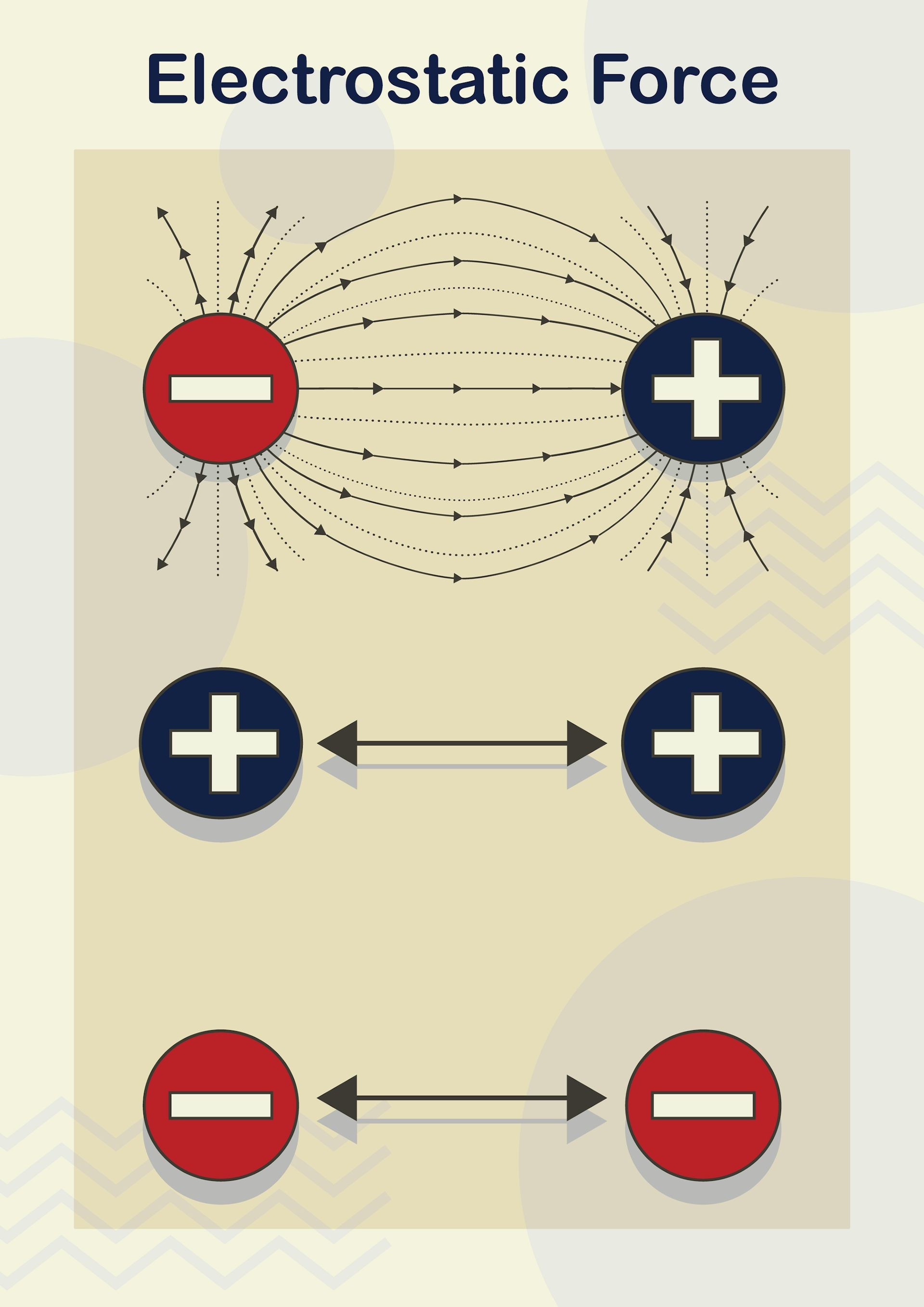Why Do I Have So Much Static Electricity? Static electricity can be annoying, but understanding its origins, as explained by WHY.EDU.VN, can empower you to minimize those unexpected jolts. By delving into the science behind static charges and learning practical tips, you can effectively manage static buildup in your daily life. Consider factors like humidity, materials, and personal habits to reduce static cling and those unwanted shocks.
1. Unveiling the Mystery: What is Static Electricity?
Static electricity is a phenomenon where an electrical charge builds up on the surface of an object. This buildup typically occurs when two surfaces are rubbed together, causing electrons to move from one object to another. Let’s dive deeper into the fundamentals.
1.1 The Atomic Foundation: Protons, Neutrons, and Electrons
To truly understand static electricity, we must first understand atoms, the building blocks of all matter. Each atom consists of:
- Protons: Positively charged particles located in the nucleus (the atom’s center).
- Neutrons: Neutrally charged particles also in the nucleus.
- Electrons: Negatively charged particles that orbit the nucleus.
Normally, an atom has an equal number of protons and electrons, making it electrically neutral. However, this balance can be disrupted.
1.2 The Role of Electric Charge: Positive and Negative
Electric charge is a fundamental property of matter that can be either positive or negative.
- Positive Charge: Associated with protons.
- Negative Charge: Associated with electrons.
Opposite charges attract each other, while like charges repel. This attraction and repulsion are what govern the behavior of static electricity.
1.3 The Imbalance: How Static Charge Accumulates
Static electricity arises when there’s an imbalance of electric charges on a surface. This usually happens through the triboelectric effect, where friction between two materials causes electrons to transfer.
Here’s how it works:
- Contact and Separation: When two materials are brought into contact and then separated, electrons can be transferred from one surface to the other.
- Electron Transfer: The material that loses electrons becomes positively charged, while the material that gains electrons becomes negatively charged.
- Charge Accumulation: If the materials are insulators (materials that don’t easily conduct electricity), the charges remain on the surface, leading to a buildup of static electricity.
1.4 Static Discharge: The Zap!
Once a static charge has built up, it can be discharged when the charged object comes into close proximity with another object, especially a conductor (a material that easily conducts electricity). This discharge is what you feel as a static shock. The electrons rapidly move to neutralize the charge imbalance, creating a small electric current.
2. Common Causes of Static Electricity Buildup
Several factors contribute to static electricity buildup. Understanding these causes can help you take steps to minimize static shocks.
2.1 The Triboelectric Effect: Friction is Key
As mentioned earlier, the triboelectric effect is a primary cause of static electricity. This effect occurs when two materials are rubbed together, causing electrons to transfer from one surface to the other. The materials’ affinity for electrons determines which material gains or loses them.
Here are some common examples of the triboelectric effect:
- Rubbing a balloon on your hair: The balloon becomes negatively charged, while your hair becomes positively charged, causing your hair to stand on end.
- Walking across a carpet: Friction between your shoes and the carpet can cause you to accumulate a static charge.
- Removing clothes: Synthetic fabrics like polyester and nylon are prone to generating static electricity when rubbed against other materials.
2.2 Environmental Factors: Humidity and Temperature
The environment plays a significant role in static electricity buildup. Humidity and temperature are two key factors:
- Humidity: High humidity reduces static electricity because moisture in the air helps to dissipate charges. Water molecules are polar, meaning they have a slightly positive end and a slightly negative end. These polar molecules attract and neutralize static charges, preventing them from building up.
- Temperature: Cold, dry air is more conducive to static electricity. In winter, when the air is dry, static shocks are more common. The lack of moisture in the air allows charges to build up more easily.
2.3 Material Properties: Conductors vs. Insulators
The materials involved also greatly influence static electricity. Materials can be broadly classified as conductors or insulators:
- Conductors: Materials that allow electric charge to flow freely through them. Examples include metals like copper, aluminum, and gold.
- Insulators: Materials that resist the flow of electric charge. Examples include rubber, plastic, glass, and dry air.
Insulators are more prone to static electricity buildup because they don’t allow charges to dissipate easily. When charges accumulate on an insulator, they tend to stay there, leading to a static charge.
2.4 Clothing and Fabrics: What You Wear Matters
The type of clothing you wear can significantly impact static electricity buildup. Synthetic fabrics like polyester, nylon, and acrylic are more likely to generate static electricity than natural fibers like cotton, wool, and silk. This is because synthetic fabrics tend to be more insulating and have a greater tendency to gain or lose electrons during friction.
Here’s a comparison of different fabrics:
| Fabric | Static Electricity Potential | Reason |
|---|---|---|
| Polyester | High | Synthetic material with a high tendency to gain or lose electrons. |
| Nylon | High | Similar to polyester, nylon is a good insulator that easily generates static. |
| Acrylic | High | Another synthetic fabric that is prone to static buildup. |
| Cotton | Low | Natural fiber with better conductivity, reducing static. |
| Wool | Medium | Natural fiber, but can still generate some static, especially in dry conditions. |
| Silk | Low | Natural fiber with good conductivity, making it less prone to static. |



2.5 Personal Habits and Activities
Certain personal habits and activities can also contribute to static electricity buildup:
- Walking on carpets: As mentioned earlier, walking on carpets, especially with rubber-soled shoes, can generate static electricity.
- Brushing your hair: Brushing your hair, particularly with a plastic brush, can cause static electricity, leading to flyaway hair.
- Working with electronics: Handling electronic components can generate static electricity, which can damage sensitive devices.
3. Why Me? Factors Contributing to Individual Differences
Not everyone experiences static shocks with the same frequency or intensity. Several factors contribute to these individual differences.
3.1 Body Size and Sensitivity
Body size can influence static electricity buildup. A larger body has a greater surface area, which means it can accumulate more charge. However, sensitivity to static shock also varies from person to person. Some people have a lower threshold for feeling the zap, while others are less sensitive.
- Body Size: Larger individuals may accumulate more charge.
- Sensitivity: Varies from person to person; some feel shocks more intensely.
3.2 Skin Hydration
Dry skin is more prone to static electricity. When your skin is dry, it becomes a better insulator, allowing charges to build up more easily. Keeping your skin moisturized can help reduce static shocks.
3.3 Clothing Choices
As previously discussed, clothing choices play a significant role in static electricity buildup. Individuals who wear synthetic fabrics regularly are more likely to experience static shocks.
3.4 Environmental Exposure
People who live in dry climates or spend a lot of time in air-conditioned environments are more prone to static electricity due to the low humidity.
4. The Science Behind Static Cling
Static cling is a common annoyance that occurs when static electricity causes fabrics to stick together. This phenomenon is closely related to static electricity.
4.1 How Static Cling Happens
When two fabrics with opposite static charges come into contact, they attract each other. This attraction is what causes static cling. The fabric with the negative charge is attracted to the fabric with the positive charge, resulting in the two materials sticking together.
4.2 Factors Affecting Static Cling
Several factors influence static cling:
- Fabric Type: Synthetic fabrics are more prone to static cling.
- Humidity: Low humidity increases static cling.
- Friction: Increased friction leads to more static buildup and cling.
5. Dangers and Drawbacks of Static Electricity
While static shocks are usually harmless, they can be a nuisance and pose some risks in certain situations.
5.1 Annoyance and Discomfort
The most common drawback of static electricity is the annoyance and discomfort of static shocks. These zaps can be startling and unpleasant, especially when they occur frequently.
5.2 Damage to Electronics
Static electricity can damage sensitive electronic components. An electrostatic discharge (ESD) can destroy or degrade electronic devices, leading to malfunction or failure. This is why it’s important to take precautions when working with electronics, such as wearing an anti-static wrist strap.
5.3 Ignition of Flammable Materials
In certain industrial settings, static electricity can pose a fire hazard. A static spark can ignite flammable gases, liquids, or dust, leading to explosions or fires. Precautions must be taken in these environments to minimize static electricity buildup.
5.4 Interference with Manufacturing Processes
Static electricity can interfere with various manufacturing processes. For example, in the printing industry, static electricity can cause paper to stick together, leading to jams and printing errors.
6. Practical Tips to Reduce Static Electricity
Fortunately, there are several practical steps you can take to minimize static electricity buildup and reduce static shocks.
6.1 Increase Humidity
Increasing humidity is one of the most effective ways to reduce static electricity. You can use a humidifier to add moisture to the air, especially during dry winter months. Maintaining a humidity level of 40-60% can significantly reduce static buildup.
6.2 Moisturize Your Skin
Keeping your skin moisturized can help reduce static shocks. Dry skin is more prone to static electricity, so applying lotion regularly can help maintain a protective barrier and prevent charge buildup.
6.3 Choose Natural Fabrics
Opt for clothing made from natural fabrics like cotton, wool, and silk. These materials are less prone to static electricity than synthetic fabrics. When possible, avoid wearing synthetic fabrics like polyester, nylon, and acrylic.
6.4 Use Dryer Sheets
Dryer sheets contain chemicals that help to reduce static cling in the dryer. These sheets coat the fabric with a thin layer of lubricant, which reduces friction and prevents static buildup.
6.5 Anti-Static Sprays
Anti-static sprays can be used to treat clothing, carpets, and other surfaces that are prone to static electricity. These sprays contain chemicals that neutralize static charges and prevent them from building up.
6.6 Ground Yourself
Before touching electronic devices or other sensitive equipment, ground yourself by touching a metal object. This will discharge any static electricity that has built up on your body.
6.7 Wear Shoes with Leather Soles
Shoes with leather soles are less likely to generate static electricity than shoes with rubber soles. Leather is a better conductor than rubber, so it allows charges to dissipate more easily.
6.8 Metal Key Trick
Carry a metal object, like a key or coin, and touch it to metal surfaces before you touch them with your hand. The metal will discharge the static electricity, preventing you from feeling a shock.
7. Static Electricity in Specific Scenarios
Static electricity can be particularly problematic in certain situations. Here are some tips for managing static in these scenarios.
7.1 In the Office
Offices often have dry air due to air conditioning, which can lead to static electricity buildup. Use a humidifier, anti-static sprays, and choose natural fabrics for clothing. Ground yourself before touching electronic equipment.
7.2 At Home
Use a humidifier to maintain proper humidity levels. Avoid walking on carpets with rubber-soled shoes. Use dryer sheets when doing laundry. Moisturize your skin regularly.
7.3 While Traveling
Traveling, especially in airplanes, can lead to dry skin and increased static electricity. Drink plenty of water to stay hydrated. Apply lotion to your skin. Choose natural fabrics for clothing.
7.4 Working with Electronics
When working with electronics, wear an anti-static wrist strap to ground yourself. Use anti-static mats on your work surface. Avoid wearing synthetic clothing.
8. Advanced Techniques for Static Control
In industries where static electricity is a major concern, more advanced techniques are used for static control.
8.1 Ionization
Ionization involves using devices to generate ions (charged particles) in the air. These ions neutralize static charges on surfaces, preventing buildup.
8.2 Conductive Materials
Using conductive materials in flooring, furniture, and equipment can help to dissipate static charges. Conductive materials allow charges to flow freely to ground, preventing buildup.
8.3 Shielding
Shielding involves enclosing sensitive equipment in conductive enclosures to protect it from electrostatic discharge. The enclosure acts as a Faraday cage, preventing electric fields from penetrating.
9. Debunking Myths About Static Electricity
There are several common misconceptions about static electricity. Let’s debunk some of these myths.
9.1 Myth: Static Electricity Only Occurs in Winter
While static electricity is more common in winter due to dry air, it can occur at any time of the year. Low humidity is the primary factor, so static electricity can occur in any dry environment.
9.2 Myth: Static Shocks are Dangerous
Static shocks are usually harmless, although they can be unpleasant. The voltage of static shocks can be high, but the current is very low, so they don’t pose a significant health risk.
9.3 Myth: Wearing Rubber Shoes Prevents Static
Wearing rubber shoes can actually increase static electricity buildup. Rubber is an insulator, so it prevents charges from dissipating, leading to a buildup of static electricity.
10. Seeking Expert Advice on Static Electricity
For more in-depth information on static electricity and how to manage it, consult the experts at WHY.EDU.VN. Our team of specialists can provide tailored advice and solutions for your specific needs.
10.1 Contacting WHY.EDU.VN
For expert advice and solutions, please contact us:
- Address: 101 Curiosity Lane, Answer Town, CA 90210, United States
- WhatsApp: +1 (213) 555-0101
- Website: WHY.EDU.VN
11. FAQ: Your Questions About Static Electricity Answered
Here are some frequently asked questions about static electricity.
11.1 Why Do I Get More Static Shocks in Winter?
The air is drier in winter, which allows static charges to build up more easily.
11.2 How Can I Prevent Static Cling?
Use dryer sheets, anti-static sprays, and choose natural fabrics.
11.3 Are Static Shocks Harmful?
No, static shocks are usually harmless.
11.4 What Fabrics Generate the Most Static?
Synthetic fabrics like polyester and nylon generate the most static.
11.5 Does Moisturizing Help with Static?
Yes, moisturizing your skin can help reduce static shocks.
11.6 Can Static Electricity Damage Electronics?
Yes, static electricity can damage sensitive electronic components.
11.7 How Does Humidity Affect Static Electricity?
High humidity reduces static electricity by dissipating charges.
11.8 What is the Triboelectric Effect?
The triboelectric effect is the generation of static electricity through friction between two materials.
11.9 Why Does My Hair Get Static?
Brushing your hair, especially with a plastic brush, can cause static electricity.
11.10 What is the Best Way to Ground Myself?
Touch a metal object to discharge static electricity.
12. Call to Action: Get Your Questions Answered at WHY.EDU.VN
Still have questions about static electricity? Don’t rely on unreliable sources. Visit WHY.EDU.VN today to ask your questions and get answers from our team of experts. We provide accurate, detailed, and easy-to-understand explanations to help you understand the world around you. Contact us at 101 Curiosity Lane, Answer Town, CA 90210, United States, WhatsApp: +1 (213) 555-0101, or visit our website at WHY.EDU.VN. Discover the answers you’ve been searching for with why.edu.vn!
